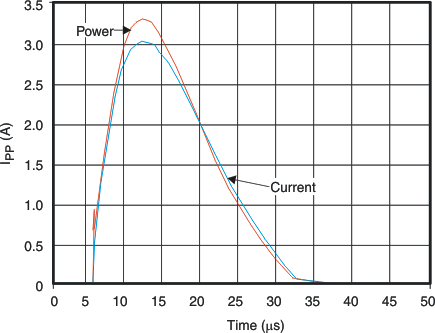SLVS928B March 2009 – August 2014 TPD4S012
UNLESS OTHERWISE NOTED, this document contains PRODUCTION DATA.
- 1 Features
- 2 Applications
- 3 Description
- 4 Revision History
- 5 Pin Configurations and Functions
- 6 Specifications
- 7 Detailed Description
- 8 Applications and Implementation
- 9 Power Supply Recommendations
- 10Layout
- 11Device and Documentation Support
- 12Mechanical, Packaging, and Orderable Information
Package Options
Mechanical Data (Package|Pins)
- DRY|6
Thermal pad, mechanical data (Package|Pins)
- DRY|6
Orderable Information
6 Specifications
6.1 Absolute Maximum Ratings
Over operating free-air temperature range (unless otherwise noted)| PARAMETER | MIN | MAX | UNIT | |||
|---|---|---|---|---|---|---|
| VBUS voltage tolerance | VBUS pin | –0.3 | 20 | V | ||
| IO voltage tolerance | D+, D–, ID pins | –0.3 | 6 | V | ||
| TA | Operating free-air temperature range | –40 | 85 | °C | ||
| IEC 61000-4-2 Contact Discharge | D+, D–, ID | ±10 | kV | |||
| VBUS pin | ±10 | kV | ||||
| IEC 61000-4-2 Air-Gap Discharge | D+, D–, ID | ±10 | kV | |||
| VBUS pin | ±9 | kV | ||||
| IEC 61000-4-5 Surge (tp = 8/20 μs) | Peak pulse Power (All pins) | 60 | W | |||
| Peak pulse current (All Pins) | 3 | A | ||||
6.2 Handling Ratings
| MIN | MAX | UNIT | |||
|---|---|---|---|---|---|
| Tstg | Storage temperature range | –65 | 125 | °C | |
| V(ESD) | Electrostatic discharge | Human body model (HBM), per ANSI/ESDA/JEDEC JS-001, all pins(1) | –2.5 | 2.5 | kV |
| Charged device model (CDM), per JEDEC specification JESD22-C101, all pins(2) | –1 | 1 | |||
(1) JEDEC document JEP155 states that 500-V HBM allows safe manufacturing with a standard ESD control process.
(2) JEDEC document JEP157 states that 250-V CDM allows safe manufacturing with a standard ESD control process.
6.3 Recommended Operating Conditions
over operating free-air temperature range (unless otherwise noted)| PARAMETER | MIN | MAX | UNIT | |
|---|---|---|---|---|
| TA Operating free-air Temperature Range | –40 | 85 | °C | |
| Operating Voltage | VBUS Pin | 0 | 15 | V |
| D+, D–, ID Pins | 0 | 5.5 | ||
6.4 Thermal Information
| THERMAL METRIC(1) | TPD4S012 | UNIT | |
|---|---|---|---|
| DRY | |||
| 6 PINS | |||
| RθJA | Junction-to-ambient thermal resistance | 461.3 | °C/W |
| RθJC(top) | Junction-to-case (top) thermal resistance | 219.6 | |
| RθJB | Junction-to-board thermal resistance | 343.7 | |
| ψJT | Junction-to-top characterization parameter | 162.5 | |
| ψJB | Junction-to-board characterization parameter | 343.7 | |
(1) For more information about traditional and new thermal metrics, see the IC Package Thermal Metrics application report, SPRA953.
6.5 Electrical Characteristics
over operating free-air temperature range (unless otherwise noted)| PARAMETER | TEST CONDITIONS | MIN | TYP | MAX | UNIT | ||||
|---|---|---|---|---|---|---|---|---|---|
| IVBUS | VBUS operating current | VBUS = 19 V | D+, D–, ID pins open | 0.1 | 0.5 | μA | |||
| IIO | IO port current | VIO = 2.5 V, VBUS = 5 V | D+, D–, ID pins | 0.1 | 0.5 | μA | |||
| VD | Diode forward voltage | IIO = 8 mA | D+, D–, ID pins (lower clamp diode) | 0.6 | 0.8 | 0.95 | V | ||
| CVBUS | VBUS pin capacitance | VBUS = 5 V | 11 | 15 | pF | ||||
| CIO | IO capacitance | VIO = 2.5 V | D+, D–, ID pins | 0.8 | 1 | pF | |||
| RDYN | Dynamic resistance | IIO = 1.5 A | D+, D–, ID, and VBUS pins, including central clamp dioded during positive ESD pulse | 1.2 | Ω | ||||
| IIO = 1 A | D+, D–, ID, and VBUS pins, including central clamp diode during negative ESD pulse | 1 | |||||||
| VBR | Breakdown voltage | IIO = 1 mA | D+, D–, ID pins | 6 | 9 | V | |||
| VBUS pin(s) | 20 | 24 | |||||||
6.6 Typical Characteristics
 Figure 1. Peak Pulse Power Waveform at the D+, D–, or ID Pin
Figure 1. Peak Pulse Power Waveform at the D+, D–, or ID Pin
 Figure 3. D+, D–, or ID Clamp Voltage Under ESD Event
Figure 3. D+, D–, or ID Clamp Voltage Under ESD Event
 Figure 5. D+, D–, or ID Capacitance, TA = 27°C
Figure 5. D+, D–, or ID Capacitance, TA = 27°C
 Figure 7. IEC Clamping Waveform, 8 kV Contact, D+, 25 ns/div
Figure 7. IEC Clamping Waveform, 8 kV Contact, D+, 25 ns/div
 Figure 9. VBUS IEC Clamping Waveform, 8 kV Contact, 25 ns/div
Figure 9. VBUS IEC Clamping Waveform, 8 kV Contact, 25 ns/div
 Figure 2. Peak Pulse Power Waveform at the VBUS Pin
Figure 2. Peak Pulse Power Waveform at the VBUS Pin
 Figure 4. VBUS Clamp Voltage Under ESD Event
Figure 4. VBUS Clamp Voltage Under ESD Event
 Figure 6. VBUS Capacitance, TA = 27°C
Figure 6. VBUS Capacitance, TA = 27°C
 Figure 8. IEC Clamping Waveform, –8 kV Contact, D+, 25 ns/div
Figure 8. IEC Clamping Waveform, –8 kV Contact, D+, 25 ns/div
 Figure 10. VBUS IEC Clamping Waveform, –8 kV Contact, 25 ns/div
Figure 10. VBUS IEC Clamping Waveform, –8 kV Contact, 25 ns/div